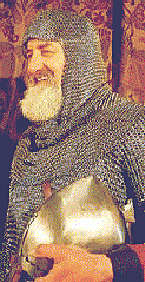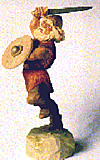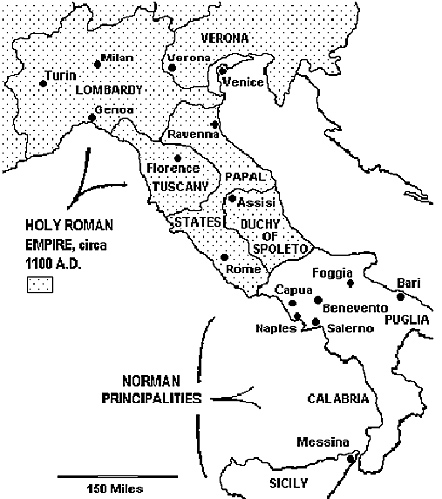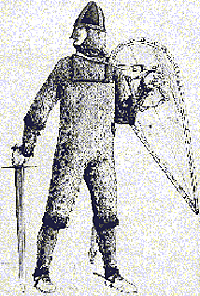 They were, depending on your point of view, splendid warriors who brought stability to a shaky continent torn asunder by other invaders or unwashed barbarians with a sense of savagery that would not be seen again until the appearance of the Mongols; or something in between; or victims of a bad press that liked its Saxon heroes. Regardless of which, the name "Norman" reverberates throughout the history of the continent until the present century, conjuring an instant mental image. But who they were and how they came to be is a bit of history that bears examination.
They were, depending on your point of view, splendid warriors who brought stability to a shaky continent torn asunder by other invaders or unwashed barbarians with a sense of savagery that would not be seen again until the appearance of the Mongols; or something in between; or victims of a bad press that liked its Saxon heroes. Regardless of which, the name "Norman" reverberates throughout the history of the continent until the present century, conjuring an instant mental image. But who they were and how they came to be is a bit of history that bears examination.
Civilization?
Viking raiders, constantly haranguing the northern coast of France, were granted lands to settle in 911 by West-Frankish King Charles the Simple. The Viking leader, Rollo, readily agreed to this, changing his name to Robert and even being converted to Christianity as part of the treaty of St. Clair-sur-Epte. Thus were the race known as Normans born.
 They quickly consolidated their gains, obtaining fresh land grants in 924 and 933. The traditional view of this early Norman state is that it was defined by the strict Carolingian rules of administration, a situation they would have inherited from the Franks. Different districts were clearly defined and the running of these districts were along more or less feudal lines, a lord apportioning land in return for military service. More recent assessments of the situation have freshly defined Normandy as the result of almost immediate expansionism brought about by those Viking Warrior settlers brought in to bolster the population against potential aggression.
They quickly consolidated their gains, obtaining fresh land grants in 924 and 933. The traditional view of this early Norman state is that it was defined by the strict Carolingian rules of administration, a situation they would have inherited from the Franks. Different districts were clearly defined and the running of these districts were along more or less feudal lines, a lord apportioning land in return for military service. More recent assessments of the situation have freshly defined Normandy as the result of almost immediate expansionism brought about by those Viking Warrior settlers brought in to bolster the population against potential aggression.
They also converted to Christianity and embraced their new culture. Even two generations later, Scandinavian culture was fast disappearing as Viking settlers assimilated both Christianity and their new Gallo-Frankish way of life. Rollo’s successor, William Longsword, was forced to send his own son away to learn Danish as there were none who could teach the language in his court. The Normans became:
- “..more Frankish than the Franks, having taken and developed Frankish Language, religion and Feudalism, Frankish War and Law and a
Carolingian concept of the state, a new monasticism and a new architecture.”
A warrior spirit combined with Viking wanderlust, shipbuilding and a gift for assimilating the ways of their chosen settled lands went a long way towards Norman prosperity and growth. The Normans never completely forgot their Viking heritage however. A depiction of Duke William’s banners from the Bayeaux Tapestry clearly shows the black bird of Odin.
The Normans’ faith became a large part of their identity, Deus Aie ‘God help us’ becoming their battle cry. They quickly began rebuilding Christian infrastructure, especially the monasteries, which had been driven away by relentless Norse-Viking raids (those of their immediate ancestors!) over the years.
Patronage of the church, most especially Monks, was very important to the Norman Warrior Lord. Sin was something that could be absolved, washed away if you like. Warriors accumulated sins in their everyday life as well as in their chosen profession. The taking of a life, especially a Christian life, was itself a sinful act. The average Norman noble was far too busy to attend to his own absolution so he would hire monks to do it for him. Every day, the monks would pray for the soul of their lord. Giving them sturdy buildings to live in was, in some ways, an insurance policy assuring the permanency of the house they founded thus prolonging the length of time they would receive benefit of prayer. As Monasticism flourished, so the Church became more obliged to the Norman aristocracy for its power, one supporting the other.
 Warriors for Export
Warriors for Export
The greatest export of the Norman nation were its warrior-knights. The Norman nobility, even up to the Duke, were obliged to be warriors, and great warriors were bred to lead from the front. The fact that they underwent the same formal training as knights of lesser birth, and had to earn their knighthoods in the same way, raised the status of the title knight. The knights were also in the forefront of military technology, the heavy cavalryman. Full-length chainmail hauberk, conical helm, kite shield, lance, sturdy war-horse and a steady saddle and stirrups to hold him in as he charged down his enemies. This sort of technology was expensive however, and the Knights, in accordance with their status, needed lands to support them as part of their feudal lord’s household.
The knight, in combination with another piece of Norman technology, the castle, provided the sort of superiority or supremacy that can be likened to air superiority or supremacy in modern warfare.
Control of the skies, or, in the Norman’s case, control of the land, leads to victory. Castles were not just defensive structures for, in conjunction with cavalry, they could be just as offensive as their garrison ranged out by day to strike their enemies whilst enjoying protection at night or at times when they were vulnerable. Normandy was “studded with castles of Dukes and vassals” and such a castle building program made all Norman conquests, England, Italy, Sicily and the Holy land, lasting if not permanent. The problem with having so many knights, elevating their status, obliging them to equip themselves in the latest technology available and instilling upon them a feudal and chivalric honor which prevents them from fighting among themselves, is that the country becomes too small to sustain them all. Younger sons and other exiles, too proud to allow themselves to become impoverished, had to find other places in which to forge their fortunes.
 Wandering to Sicily
Wandering to Sicily
Small independent groups began to travel as mercenaries, and many found themselves in southern Italy and Sicily, where there was little in the way of political and cultural unity, with a mix of territories in Lombard, Byzantine and Muslim control, each with distinct cultural attitudes. These mercenary Normans slowly acquired lands for themselves and employed the trusted tactic of assimilation building up their holdings until, ultimately, they were the major forces in each area. They were not afraid to keep up with ways different to those found in the north, especially where a financial or cultural advantage could be obtained, such as silk factories in Italy or a tolerance for Muslim scholarship in Sicily.
Architecture was recognizably Norman, but with a great deal of influence from what they found around them be it Muslim or Byzantine, so that Northern visitors might be shocked at the native element they saw, yet the natives weren't overtly shown the different nature of their new Norman masters.
The Norman alliance with the Papacy, long established via their generous patronage of the church, was firmly consolidated in the southern lands. Though Italy was technically part of the Holy Roman Empire, in reality their influence was confined to Northern Italy. The Empire tried ranging south, if nothing more than to directly control the Papacy, yet were always thwarted in their attempts by the presence of the Normans. The papacy needed the Normans more than ever and so supported their cause, wherever they might be (including blessing the invasion of England in 1066).
- “The Normans were the glorious adventurers of the Mediterranean world throughout the eleventh century which constituted the great period of Norman expansion”
Historians agree that there is a romantic notion to the story of the Normans in Italy and Sicily. A few poor Knights triumphantly winning large, rich and well populated lands against the odds. Some argue that it was merely an extension of the Viking interest in plunder and booty, though there is more. The Normans brought some order to their lands without imposing their cultural will on the people.
On the contrary, they were willing to adopt the cultures of the lands they occupied, becoming more native than the natives while doing so. They held advantages in military technology with their cavalry and castle building and their faith lent them a powerful spiritual ally in the papacy as well as a more grass roots support from the monasteries which they founded wherever they went.
Since their penetration of a new culture was at a noble level, it meant that the ordinary people saw little change save the look and the language of the landowner, a fact which often changed within one generation anyway. Secular and ecclesiastical government being under one roof, the Normans imported their own church leaders, who did not even have to be Norman, just swearing their allegiance to the Norman liege lord. Rollo, as well as converting to Christianity, married twice, to the daughter of Charles the Simple and the daughter of a Frankish count of Bayeux, from whom the great dynasty of Dukes was born. The Sicilian Normans did exactly the same, gaining respectability by marrying into the racial nobility of the country.
 In Normandy, the Carolingian legacy of the importance of the liege lord was an important factor in the growth of Norman power. How you came to be the feudal lord was not as important as the fact that once in that position, your power was absolute. That the Vikings adopted this system so easily lent them credibility in the eyes of their neighbors, who were at once more loath to try anything against them. An instant respectability where before there had been none, all down to the adoption of a title and a way of ruling. The Normans took this organization with them wherever they went and it served them well. They controlled military service, limited war between individual nobles, licensed and regulated castle building, monopolized coinage, entrusted local government to lesser officials and allowed them to get on with it, and, though the ecclesiastical authorities might have disagreed, controlled the church through their indispensable patronage.
In Normandy, the Carolingian legacy of the importance of the liege lord was an important factor in the growth of Norman power. How you came to be the feudal lord was not as important as the fact that once in that position, your power was absolute. That the Vikings adopted this system so easily lent them credibility in the eyes of their neighbors, who were at once more loath to try anything against them. An instant respectability where before there had been none, all down to the adoption of a title and a way of ruling. The Normans took this organization with them wherever they went and it served them well. They controlled military service, limited war between individual nobles, licensed and regulated castle building, monopolized coinage, entrusted local government to lesser officials and allowed them to get on with it, and, though the ecclesiastical authorities might have disagreed, controlled the church through their indispensable patronage.
References
Brown, R. Allen. The Normans. Boydell Press, 1994
Davis, RHC. The Normans and their Myth. Thames and Hudson, 1976
Haskins, Charles H. The Normans in European History. W. W. Norton, 1966
Back to Cry "Havoc!" #41 Table of Contents
Back to Cry "Havoc!" List of Issues
Back to MagWeb Master Magazine List
© Copyright 2003 by David W. Tschanz.
This article appears in MagWeb.com (Magazine Web) on the Internet World Wide Web. Other articles from military history and related magazines are available at http://www.magweb.com